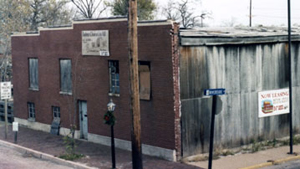
Blanchette's Mill, 921 South Main, ca. 1977
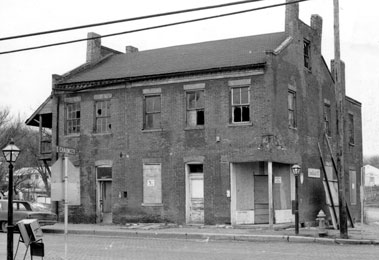
Western House, 1001 South Main, ca. 1975
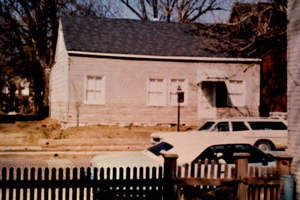
French House, 719 South Main, ca. 1974
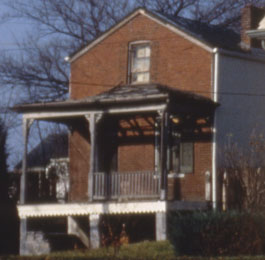
833 South Main
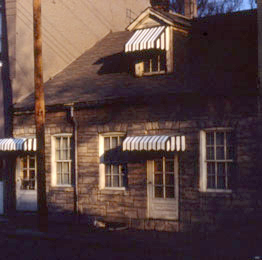
612 South Main
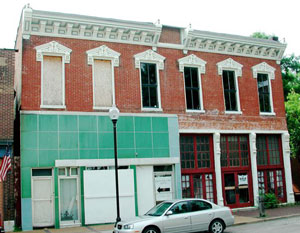
Cosmos Bldg, 136 South Main, ca. 1975
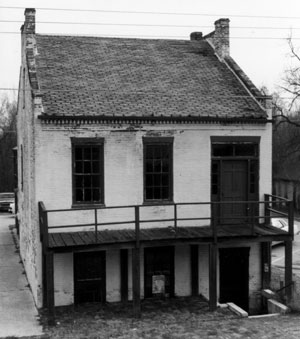
1000 South Main, ca 1975
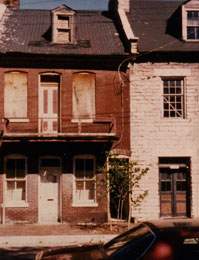
322 South Main
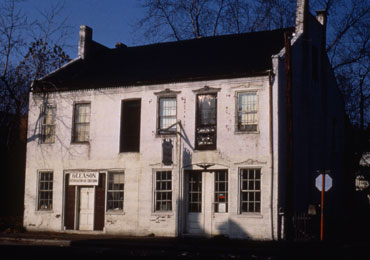
701-703 South Main
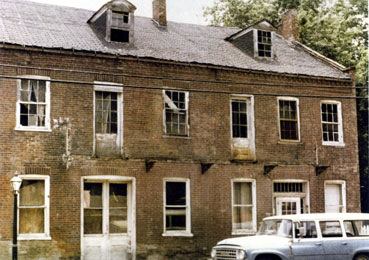
700 South Main
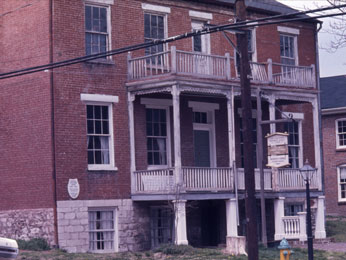
625 South Main
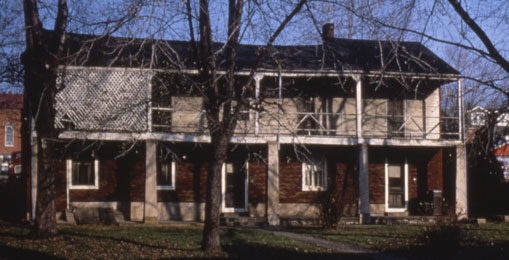
319 South Main
|
RESTORATION HISTORY
The most influential beginning of historic preservation in St. Charles began in the early 1960's when a small group banded together to bring about the purchase of property which had been the legislator’s meeting site in the days of the formation of the State of Missouri. By the mid 60's, the group had secured funding for restoration and obtained commitments from the State of Missouri to be the permanent custodian of the first state capitol property. St. Charles’ identity as the First State Capitol of Missouri had been established.
Awareness of the value of the many early 1800's structures to the entire community resulted in city officials creating a special zoning district named HD Historic District. This restricted zoning was pioneering in its time, and was the origin of this Architectural Review Board. Only a few buildings had been repaired then and many were in jeopardy of actually falling down. Those Board Members had only a few words of guidance and no money for consultants or studies. Their work was challenging: equally challenging was the work of securing a "permit". Yet it serves today, 40 years later, as precedent.
A larger volunteer group, in a companion 1960's effort, researched and documented the history and architecture of Main Street properties from Madison to just south of Main at Boone’s Lick Road which supported the nomination of the area to the National Register of Historic Places. And in June of 1970, the "Main Street Historic District" was recognized to be of National importance and officially placed on the National Register of Historic Places. Only a few areas had been similarly recognized as districts at that time.
The Historical Society group and several others had renovated a few of our historic buildings in the 1960's, but the early 1970's saw dozens more new restoration projects completed. Business enterprises had become well established. Millions of federal dollars became available to be spent on historic demonstration projects and redevelopment of the Historic District and larger surrounding area: the river front was cleaned and filled in to become Frontier Park. Riverside Drive was constructed along with parking areas throughout. The structural and exterior work on Stone Row, Farmers Tavern and Western House was completed creating opportunity for private owners to finish the projects. Storage lots for wrecked cars and lumber were relocated, including the City’s storage of street salt and equipment. New construction in the character of the older buildings filled in. Kister Park and Berthold Square park spaces were also created, and I am proud that both were designed by my husband, George.
By the end of the 70's, interest in restoration and reuse of older buildings had widely expanded to include many residences and the neighborhood of Frenchtown. The industry of tourism, centered on the historic character of our community, became an important part of the local economy with voluntary tax districts funding the initial efforts.
The 1980's can be marked by expanded participation in rehabilitation and restoration, and especially the official local recognition of additional historic districts with special zoning. Frenchtown, and the Downtown area further north on Main Street, received their much deserved recognition with placement on the National Register of Historic Places. And the responsibilities of the Landmarks Board were also expanded.
By the 90's we observe that the image of St. Charles was centered on the historic character of our residences, buildings, and businesses. They became the foundation of the maturing Visitor and Convention industry and represented the entrepreneurial spirit of our citizens. Numerous chapters of the Zoning Ordinance rewritten, updated and adopted in 1998 are committed to guiding the recognition, preservation, restoration, and new development in and near our Historic Districts. The Comprehensive Plan of 2002 reinforces these guidelines, citing as part of the Vision Statement "The long-term growth and quality of life shall be guided by these principals - to preserve and enhance our rich historical heritage...which establish St. Charles as one of America’s most liveable communities."
In 1999, the City committed to being an active partner in the Federal Historic Preservation Program, accepting responsibilities to continue preservation projects, and it was named a Certified Local Government. New preservation funding sources and federal and state tax credit incentives became available along with access to expert technical advice of partner agencies.
The 200 year anniversary celebration of Lewis and Clark’s Expedition to the West brought additional National Recognition to St. Charles in 2004. Boone’sLick Road’s significance in the westward expansion from the period of trappers, stagecoaches, and the Lewis and Clark expedition is well established. The publically financed improvements to Boone’s Lick Corridor highlight this entrance to the historic districts.
2008 has brought the additional honor of St. Charles being named a "Preserve America City". Along with more important national recognition, additional preservation related funds will be available.
Today we are proud property and business owners in our City’s Historic Preservation Districts. Many pledged everything of value they owned as security to finance their purchase; they begged for insurance coverage to protect their investment; they kept their ‘day job’ and worked nights and weekends, regularly engaging their friends to help. Most projects were considered " not economically feasible", but they moved ahead, some even when interest rates were 15%. All have appeared before Landmarks Board for approval of projects big and small, having committed 25 and 35 years to their effort. All regularly participate in community wide efforts of many kinds.
So, though most are gone now, we express our thanks to our 60's preservation pioneers. And as we prepare to celebrate the Bicentennial year of our City’s official incorporation, we affirm our respect for our community's history, our honor to those who have passed these treasures on to us, and our commitment to protect these structures which represent our past. They are of national historical significance. They are our identity - our past, our present and our future.
(Sharlotte Worthington speaking to HLPARB on 9/18/06 - edited) |

